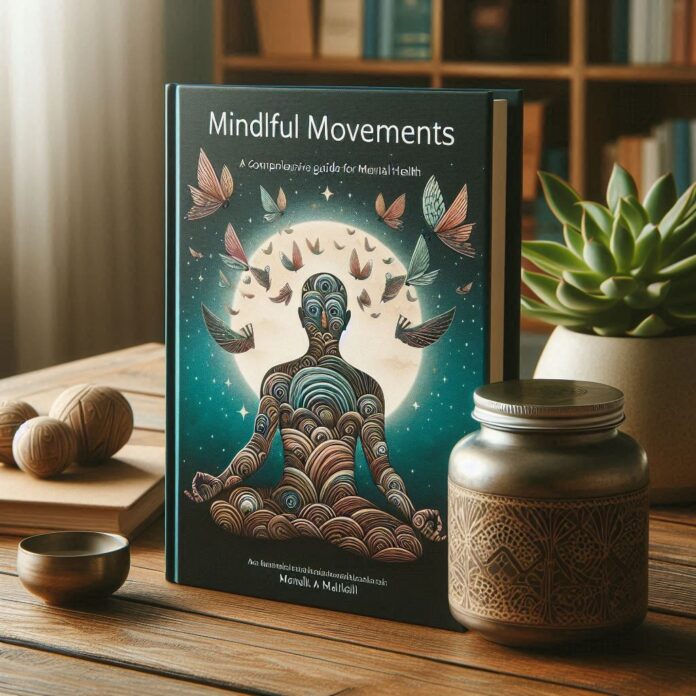In today’s fast-paced world, mental health has become a priority for many, and yoga offers a holistic approach to nurturing both the mind and body. This guide explores the transformative power of yoga, detailing how specific practices can significantly alleviate stress, anxiety, and depression. From gentle poses and mindful breathing techniques to meditative practices aimed at cultivating inner peace, we will delve into how yoga can be integrated into daily routines to promote mental well-being. Whether you are a beginner or an experienced practitioner, this article provides valuable insights and practical steps to help you harness the therapeutic benefits of yoga for a healthier, more balanced life.
I. Choose the Right Type of Yoga:
Yoga, an ancient practice with origins stretching back thousands of years in India, has become a popular tool for promoting mental well-being in our modern world. This practice not only fosters physical flexibility and strength but also enhances mental health through various styles tailored to different needs and preferences. Here, we explore some of the most beneficial types of yoga for mental health, explaining how each can help soothe your mind and fortify your spirit.
1. Hatha Yoga: The Foundation of Balance and Calm.
Hatha yoga is often recommended for beginners due to its slow pace and focus on basic postures and breath control. This style is particularly effective for stress reduction. The gentle movements and deep breathing are essential tools for calming the nervous system and alleviating symptoms of anxiety and depression. The practice encourages mindfulness and presence, which are key elements in managing stress and emotional instability.
2. Ashtanga Yoga: Discipline and Mental Clarity.
Ashtanga yoga is a more vigorous style that follows a specific sequence of poses. This method is highly structured and requires a certain level of physical fitness, making it ideal for those who find mental clarity through intense physical activity. Regular practice of Ashtanga enhances focus and determination, teaches patience, and can significantly reduce the presence of stress hormones in the body.
3. Kundalini Yoga: Unlocking Emotional Balance.
Kundalini yoga focuses on awakening the energy at the base of the spine and bringing it upward through the chakras. This type of yoga includes a combination of spiritual and physical practices that involve chanting, meditation, dynamic breathing techniques, and yoga postures. It’s particularly effective for people seeking to improve their mood and control emotional responses. Practitioners often experience heightened self-awareness and inner peace.
4. Yin Yoga: Deep Relaxation and Meditation.
Yin yoga is a meditative approach to yoga that is designed to target deep connective tissues like the fascia, along with the ligaments, joints, and bones. It’s slower and more meditative, giving you space to turn inward and tune into both your mind and the physical sensations of your body. Yin yoga poses are held for longer periods, typically three to five minutes, which can help in cultivating patience and greater emotional resilience.
5. Restorative Yoga: Stress Relief and Healing.
Restorative yoga is another slow-paced style designed to relax the body, calm the mind, and reduce stress. This practice utilizes props like yoga blocks, blankets, and bolsters to allow the body to fully engage without exerting effort in holding the pose. It is highly beneficial for those recovering from trauma or experiencing high levels of stress, providing a sense of peace and facilitating a deep state of relaxation.
6. Choosing the Best Yoga Style for Your Mental Health Journey:
Selecting the right type of yoga for mental health depends on individual needs and goals. Whether seeking to reduce anxiety with the gentle flows of Hatha yoga, gain clarity with the disciplined sequences of Ashtanga, or achieve emotional healing through the profound meditative states of Yin and Restorative yoga, there is a style to suit every journey toward mental wellness. Engaging regularly in yoga can be a transformative tool, offering both immediate relief and long-term benefits.
II. Recommended Postures:
Yoga, renowned for its holistic benefits, is not just a physical discipline but also a profound mental practice. Certain yoga poses, or asanas, are particularly effective for improving mental health, offering relief from stress, anxiety, and depression.
1. Balasana (Child’s Pose):

●Benefits:
Child’s Pose is a restful pose that promotes relaxation and helps to alleviate stress. It gently stretches the lower back and hips, allowing the body to unwind and release tension. This pose also encourages steady, conscious breathing, which is crucial for calming the mind.
●How to Perform?
– Start on your knees, sitting back on your heels.
– Fold forward, extending your arms in front of you or letting them rest alongside your body.
– Rest your forehead on the mat and relax your entire body, focusing on deep breathing.
2. Viparita Karani (Legs-Up-The-Wall Pose):

●Benefits:
This inversion is excellent for soothing the nervous system and can help to mitigate symptoms of anxiety and mild depression. It also allows for better circulation and can provide a sense of grounding and calm.
●How to Perform?
– Sit close to a wall and gently lie back, extending your legs up the wall.
– Keep your arms by your sides or place them in a comfortable position that promotes relaxation.
– Focus on deep, slow breaths, allowing your mind and body to release tension with each exhale.
3. Setu Bandha Sarvangasana (Bridge Pose):

●Benefits:
Bridge Pose is known for its ability to relieve stress and reduce anxiety. It opens up the chest, heart, and shoulders all areas where emotional tension is often held. This pose also strengthens the back, which can help improve body posture and alleviate back pain associated with stress.
●How to Perform?
– Lie on your back with your knees bent and feet flat on the floor, hip-distance apart.
– Press your feet into the floor and lift your hips, clasping your hands under your lower back.
– Hold the pose for several breaths, concentrating on deep breathing and opening your chest.
4. Sukhasana (Easy Pose) with Forward Bend:

●Benefits:
Easy Pose helps in opening the hips and lengthening the spine. Adding a forward bend promotes a soothing effect on the mind and aids in relieving physical and mental exhaustion.
●How to Perform?
– Sit in a cross-legged position and ensure your spine is straight.
– Gradually lean forward, extending your arms in front of you, allowing your head to drop towards the ground.
– Maintain this pose for a few minutes, focusing on your breath and allowing your thoughts to pass without attachment.
5. Ananda Balasana (Happy Baby Pose):

●Benefits:
This pose is particularly good for releasing stress and soothing fatigue. It also helps stretch the inner groins and spine, offering a sense of relief and joy.
●How to Perform?
– Lie on your back and pull your knees towards your chest.
– Grab the outside edges of your feet with your hands and open your knees wider than your torso.
– Gently pull your knees towards the ground, keeping your back flat on the floor, and rock slightly from side to side to enhance the stretch.
6. Integrating Yoga into Your Mental Health Routine:
Incorporating these yoga poses into your daily routine can significantly impact your mental health, providing a natural and effective way to cope with stress, anxiety, and depression. By taking time each day to practice these asanas, you create space for healing and mindfulness, fostering a stronger connection between mind and body.
III. Mastering Your Breath: Yoga Breathing Techniques for Mental Health.
Breathing is at the core of every yoga practice, and specific techniques, known as pranayama, can be particularly powerful in managing mental health. Pranayama, which translates to “life force extension,” involves various methods of controlling the breath to enhance vitality and improve mental, emotional, and physical health.
1. Anulom Vilom (Alternate Nostril Breathing):
●Benefits:
Anulom Vilom is excellent for reducing stress, enhancing cardiovascular function, and improving overall lung capacity. This balanced breathing technique helps harmonize the left and right hemispheres of the brain, fostering mental clarity and a calm mind.
●How to Perform?
– Sit comfortably with your spine erect and shoulders relaxed.
– Place your right thumb over your right nostril and inhale deeply through the left nostril.
– At the peak of your inhalation, close off the left nostril with your ring finger, then exhale through the right nostril.
– Continue this pattern, alternating nostrils after each inhalation.
2. Ujjayi Pranayama (The Ocean Breath):
●Benefits:
Ujjayi Pranayama is known for its ability to instill calm, balance body temperature, and increase oxygenation. It’s particularly useful in alleviating stress, anxiety, and insomnia. The soft, whispering sound created during Ujjayi acts as a meditative focus, helping to quiet the mind.
●How to Perform?
– Begin by breathing deeply in and out through your nose.
– Constrict your throat to the point where your breathing makes a rushing noise, similar to the sound of an ocean wave.
– Keep your inhalations and exhalations long and steady as you focus on the sound and feeling of your breath.
3. Bhramari Pranayama (Bee Breath):
●Benefits:
Bhramari Pranayama is effective in instantly relieving stress and cerebral tension, calming the mind almost immediately. It is also beneficial for mitigating anger and anxiety, promoting a soothing effect on the nerves, and improving concentration.
●How to Perform?
– Sit up straight in a quiet, comfortable space.
– Close your eyes and relax your face. Place your index fingers on your ears’ cartilage.
– Breathe in deeply, and as you exhale, gently press the cartilage while making a loud humming sound like a bee.
– Repeat this process 5-7 times, focusing on the sound and sensation it produces.
4. Kapalabhati Pranayama (Skull Shining Breath):
●Benefits:
This energizing breath technique enhances cognitive function by increasing oxygen flow to the brain, thereby clearing the mind and energizing the body. It is also helpful in relieving stress, improving focus, and invigorating the nervous system.
●How to Perform?
– Sit in a comfortable seated position with your spine straight.
– Take a deep breath in, and as you exhale, contract your lower belly to force the breath out in a short burst.
– Let your lungs fill naturally with a passive inhalation.
– Perform this cycle at a steady rhythm, completing 20 to 30 rounds per session.
5. Enhancing Mental Wellness Through Breath:
Yoga breathing techniques offer a profoundly effective way to enhance mental health. These practices not only improve physical health by increasing oxygen supply and stimulating the nervous system but also promote a state of mental clarity and emotional calmness. By integrating these breathing exercises into your daily routine, you can achieve a greater sense of balance and tranquility, essential for mental well-being.
IV. Harnessing Inner Peace: Yoga Meditation Techniques for Mental Health.
Meditation is a core element of yoga that significantly enhances mental health by promoting relaxation, improving concentration, and providing profound insights into the workings of the mind. Through various forms of yoga meditation, practitioners can cultivate a deep sense of peace and mental clarity, which are essential for emotional well-being.
1. Mindfulness Meditation (Vipassana):
●Benefits:
Mindfulness meditation helps in reducing stress, anxiety, and depression by encouraging practitioners to observe their thoughts and feelings without judgment. This practice improves emotional flexibility and resilience, making it easier to handle stressful situations.
●How to Perform?
– Find a quiet and comfortable place to sit with your back straight and eyes closed.
– Focus your attention on your breath, noticing the sensation of air entering and leaving your nostrils.
– When your mind wanders, gently redirect your focus back to your breath without criticism.
– Gradually expand your awareness to include the sounds around you, bodily sensations, and thoughts, observing each aspect with equanimity.
2. Transcendental Meditation (TM):
●Benefits:
TM is known for reducing symptoms of stress and anxiety through a simple, yet profound technique that involves the use of a mantra. This practice has been shown to lower blood pressure, improve blood circulation, and enhance overall emotional well-being.
●How to Perform?
– Sit comfortably with your eyes closed and silently repeat a mantra given by a certified TM teacher. This mantra is a sound or phrase that is traditionally kept secret to encapsulate its effectiveness.
– Continue repeating the mantra for 20 minutes twice a day.
– Allow thoughts to come and go naturally, returning your focus to the mantra each time.
3. Concentrative Meditation (Dharana):
●Benefits:
This form of meditation helps improve concentration and mental focus by directing attention to a single point. This could be a physical object, a specific thought, a part of the body, or even a sound. It trains the mind to focus deeply, which is beneficial for mental clarity and attention span.
●How to Perform?
– Choose a quiet place and a small object to focus on, such as a candle flame or a black dot on the wall.
– Sit in a comfortable position, relax your body, and gaze at the object without blinking as long as possible.
– Keep your mind fully engaged with the object, bringing it back whenever it wanders.
4. Loving-Kindness Meditation (Metta Bhavana):
●Benefits:
Metta Bhavana is a practice aimed at developing unconditional love and kindness towards all beings. It is particularly effective in enhancing feelings of compassion and positivity, reducing negative emotions like anger and resentment.
●How to Perform?
– Begin by sitting in a comfortable position and close your eyes.
– Visualize yourself and repeat phrases like “May I be happy, may I be well,” feeling the intention of the words.
– Gradually extend these wishes to loved ones, then to acquaintances, and finally to all beings worldwide.
5. The Path to Mental Equilibrium Through Yoga Meditation:
Yoga meditation offers powerful techniques for fostering mental health, each serving different purposes and benefits. Whether through mindfulness that promotes acceptance, TM that facilitates deep rest, concentrative meditation that sharpens focus, or Metta that cultivates an open heart, these practices can significantly enhance your psychological resilience and emotional peace. Regular meditation practice is key to reaping these benefits, leading to lasting changes in mental well-being and overall life satisfaction.
V. Building a Yoga Routine for Optimal Mental Health:
Establishing a yoga routine is not just about enhancing physical flexibility or strength; it’s also about nurturing mental resilience and emotional balance. A well-rounded yoga routine incorporates various aspects that synergistically improve mental health.
1. Consistency is Key:
●Benefits:
Regular practice helps to establish mental discipline and reduces stress levels over time. Consistency in yoga ensures that the benefits are not just temporary relief but contribute to long-term mental health improvements.
●How to Implement?
– Choose a specific time of day that suits your schedule. Morning yoga can energize your day while evening sessions might help in winding down.
– Aim to practice yoga at least three times a week. Consistent, shorter sessions are more effective than sporadic, longer ones.
2. Incorporate a Variety of Practices:
●Benefits:
Different yoga practices such as asanas (poses), pranayama (breathing exercises), and meditation can provide a comprehensive mental health workout. Each element targets different aspects of mental wellness.
●How to Implement?
– Start with gentle asanas to warm up the body, then move to more dynamic poses to build physical and mental endurance.
– Include at least 5-10 minutes of pranayama to improve oxygenation and regulate the nervous system.
– End with 5-10 minutes of meditation to calm the mind and consolidate the mental benefits of your physical practice.
3. Tailor Your Yoga to Your Emotional State:
●Benefits:
Yoga can be adapted to better address and soothe your current mental state, whether you’re feeling anxious, depressed, or stressed.
●How to Implement?
– On days when you feel low energy or mood, focus on restorative or yin yoga to nurture and calm yourself.
– When you feel tense or stressed, engage in more vigorous styles like Vinyasa or Ashtanga to burn off excess energy and stress.
– Use calming pranayama techniques like Ujjayi breath when anxious, or energizing ones like Kapalabhati when you need a lift.
4. Set an Intention for Each Practice:
●Benefits:
Setting intentions can transform your yoga practice from a mere physical activity to a profound mental and emotional exercise. It helps focus your mind, enhances your emotional resilience, and aligns your practice with your mental health goals.
●How to Implement?
– Before beginning your session, take a moment to reflect on what you wish to achieve—be it peace, strength, or forgiveness.
– Keep this intention in mind throughout your practice, letting it guide your focus and efforts.
5. Create a Dedicated Space:
●Benefits:
Having a dedicated space for yoga can significantly enhance the mental association between your environment and a mental health practice, making it easier to transition into a mindful state.
●How to Implement?
– Choose a quiet, comfortable spot in your home where you can practice undisturbed.
– Decorate the space with items that promote calmness and concentration, such as candles, soothing colors, or inspirational images.
6. Cultivating a Personalized Yoga Practice for Mental Health:
A thoughtful and personalized yoga routine can be a transformative tool for mental health. By maintaining consistency, incorporating varied practices, adjusting routines to meet emotional needs, setting intentions, and creating a conducive environment, you can maximize the mental health benefits of yoga. This holistic approach not only improves your physical health but also deeply nourishes your mental and emotional states, fostering a stronger, more resilient you.
Conclusion:
Embarking on a yoga journey can be a transformative experience for mental health. By regularly practicing the techniques outlined in this guide, you can open a new chapter in your wellness journey, one that embraces calm, clarity, and emotional resilience. Remember, the key to reaping the benefits of yoga lies in consistency and mindfulness. As you continue to explore and integrate these practices into your life, you may find not just improved mental health, but also a deeper connection with yourself. Start small, stay consistent, and let your yoga practice grow and evolve with you on your path to mental equilibrium.

